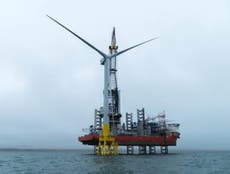The Tories are planning to halt onshore wind farm production, despite most people supporting it
The barriers to onshore wind, imposed after the general election, are about to be set in stone, as they turn from guidance to formal status

There is no better visual than the wind turbine to illustrate climate change campaigns all over the world. It has become the go-to image for every graphic designer, including those employed by our government, when addressing one of the defining challenges of our time.
In December 2017, Theresa May even sent a victorious tweet about the UK’s climate leadership, alongside an image of an onshore wind farm. But for those of us paying attention, this was a curious choice: May’s government has effectively banned onshore wind farms in England.
In 2015, seeking to shore up their right flank against defection to UKIP in the upcoming general election, the Conservatives pledged to “halt the spread of onshore wind farms”, which, they said, “often fail to gain public support”.
Once in power, uniquely stringent planning conditions were immediately placed on new wind energy developments by ministerial diktat, with no public consultation and no parliamentary scrutiny or debate. This new guidance is so vague and ambiguous that only one in four planning officials say they are confident they understand it.
And although ministers insist that there is no ban, just four wind turbines have been allowed since the new guidance came into force, according to the government’s planning database. England has seen a 94 per cent collapse in new planning applications for wind energy.
These barriers to onshore wind are about to be set in stone, as they turn from guidance to formal status as part of the planning framework.
This week, the government released the latest instalment of their public opinions tracker survey, marking five full years of official data collection on the British public’s views on climate change and energy. The most recent data shows that public support for onshore wind is now at a record high of 76 per cent – but it has never fallen below 64 per cent since the survey began.
Exploring the full five years’ of data also lets us look in detail at the very small proportion of people who are strongly opposed to onshore wind (3.5 per cent of us across the whole dataset); the current planning policy has been written for a tiny minority.
It’s interesting to look closer at the demographics within the data. Hostility to wind turbines is almost unheard of in the under-45s; the over-65s are seven times more likely to oppose onshore wind. This contrast jars awkwardly with one of the key justice issues at the heart of society’s relationship with climate change: it is a profoundly dangerous problem which is being caused predominantly by older generations, while younger people will have to live with the consequences. That older generations are also blocking the solutions to this problem seems perverse and vindictive. While some people may not like the look of wind turbines, young people really need more of them, and fast.
Worse, the data shows that the more inaccurate someone’s views about climate change are, the more likely they are to oppose onshore wind. This might seem obvious, but reflect for a moment: national planning policy is being tailored for a very small proportion of Brits who disproportionately reject the scientific consensus on climate change.
We are fortunate in the UK that these people are themselves at odds with official government policy; climate minister Claire Perry has signalled that Britain may soon move to a net zero emissions target, and her colleague Mark Field recently described climate change as “an existential threat”. But this sentiment isn’t being reflected on the ground.
It is fair to say that multinational utilities foisting industrial-scale developments on unwilling rural communities who saw little or no direct benefit was never going to end well.
But evidence shows that there is a political solution to winning public consent for new onshore wind projects: local community ownership. As smart grids spread, communities could be rewarded for hosting their own wind farms with lower energy bills as well as financial returns.
Experience shows that initial suspicion of onshore wind turbines is often short-lived, with opponents warming to the rotating blades after living with them in the landscape for a while. The village of Hockerton in Nottinghamshire went from opposing a local wind farm in 2001 to developing their own community wind project in 2008. This spring, local residents attached a picture of it on their village gateway sign.
Instead of blocking communities from building Britain’s cheapest source of new electricity, the government should be working to empower people to take a stake in the exciting energy transition of which wind turbines are just the most visible part.
From a practical perspective, the ban on onshore wind is making the urgent challenge of decarbonisation more difficult and expensive. Symbolically, it’s even worse: the ban on onshore wind reads as a ban on action on climate change. And that, increasingly, is not a good look for our government.
Leo Murray is director of strategy at 10:10, a charity that tackles climate change. You can sign the petition against the wind ban here


Join our commenting forum
Join thought-provoking conversations, follow other Independent readers and see their replies